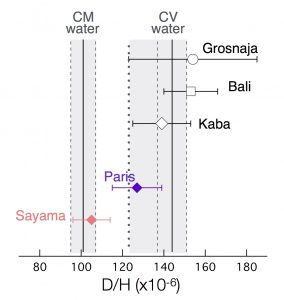Hydrogen isotopic composition of water in CV-type carbonaceous chondrites
L. Piani & Y. Marrocchi
October 2018 (Online publication). Earth and Planetary Science Letters. Volume 504, 15 December 2018, Pages 64-71.
doi: 10.1016/j.epsl.2018.09.031
In situ measurements by ion probe reveals the D/H ratio of water in chondrite: CV-type carbonaceous chondrites contain water with a D/H = [144 ± 8/21] × 10−6 that is significantly enriched in D in CV- relative to CM-type carbonaceous chondrites.
D/H ratios of water in the measured CV and CM chondrites. The average compositions of CM chondrite water (Piani et al., 2018) and CV chondrite water (this study) are distinct.
Abstract:
Among the different groups of carbonaceous chondrites, variable concentrations of hydrous minerals and organic matter are observed that might be related to the time and/or place of formation of their asteroidal parent bodies. However, the precise distribution of these volatile-bearing components between chondrite groups and their chemical and isotopic compositions remain fairly unknown. In this study, we used a novel secondary ion mass spectrometry analytical protocol to determine the hydrogen isotopic composition of water-bearing minerals in CV-type carbonaceous chondrites. This protocol allows for the first time the D/H ratio of CV chondrite hydrous minerals to be determined without hindrance by hydrogen contributions from adjacent organic material. We found that water in the altered CV chondrites Kaba, Bali, and Grosnaja has an average D/H ratio of D/H = [144 ± 8/21] x10-6 (or δD = -77 ± 54/131 ‰, 2σ), significantly higher than water in most CM-type carbonaceous chondrites (D/H = [101 ± 6] × 10–6 or δD = –350 ± 40‰, 2σ). We show that because organic matter in CV chondrites is depleted in deuterium compared to that in CM chondrites, such differences could result from isotopic exchange between water and organics. Another possibility is that the CM and CV parent bodies sampled different reservoirs of water ice and organics characterized by variable isotopic compositions due to their different time and/or place of accretion.

